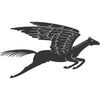Karen Solie's The Road In Is Not the Same Road Out
The Road In Is Not the Same Road Out, by Karen Solie.
Farrar, Straus and Giroux. $25.00.
When Michael Hofmann pronounced Karen Solie "one by whom the language lives" in the London Review of Books, he suggested that it would be reductionist to qualify her as a Canadian poet. At the time he was reviewing her UK debut, The Living Option, a volume of selected poems published by Bloodaxe Books in 2013. Hofmann's assertion -- repurposed from Joseph Brodsky's praise for the Australian Les Murray, now a global figure -- speaks to the universal appeal of Solie's work, but also raises questions about the perniciousness of literary borders. In Canada, Solie's first three books are revered, in large part thanks to Pigeon (2009), which won the Griffin Poetry Prize. She's now a member of the Griffin Trust, but despite the international ambitions of the award, it wasn't until Solie published outside of Canada that she saw her reputation surge to match the quality of her work. Benefitting from foreign distribution, The Living Option helped catapult Solie across the Atlantic where it was lauded in the Guardian, named a book of the year by The Independent, and was a Poetry Book Society Recommendation. In this sense, Solie's retrospective was a test run for her American debut, The Road In Is Not the Same Road Out, which was published simultaneously by Farrar, Straus and Giroux (US) and House of Anansi Press (Canada) this past spring. They sport different covers, but both jackets bear Hofmann's endorsement, claiming Solie for readers everywhere, regardless of nationality.
Yet borders are clearly on Solie's mind. She opens The Road In Is Not the Same Road Out with a "Blue jay vocaliz[ing] a clash on the colour / wheel," conjuring suburban Ontario where "tulip heads [are] removed one by one // with a sand wedge." While blue jays are endemic to the eastern and central United States as well as southern Canada, to Solie they represent her adopted city of Toronto, serving as the mascot of Toronto's major league baseball team. As if she were drawing up a list, she continues,
Something
in the frequency. Expectations are high.
There's a reason it's called the nervous
system. Someone in bed at 11 a.m.
impersonates an empty house. The sharpener's
dragged his cart from the shed. His bell
rings out from the twelfth century
to a neighbourhood traumatizing
food with dull knives. A hammer claws
to the edge of a reno and peers over. Inching
up its pole, a tentative flag. And the source?
Oh spring, my heart is in my mouth.
Read the full article on the Poetry Foundation website.
